![]()
![]()
GIZA'S
COSMIC BLUEPRINT
PART
ONE - IS CYGNUS THE KEY TO UNLOCKING
THE PYRAMIDS'GRAND UNIFIED PLAN?
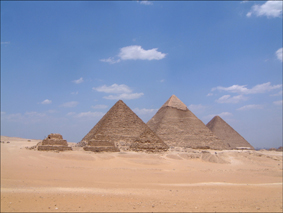
Andrew
Collins, author The Cygnus Mystery and Beneath the Pyramids, Presents
Fresh Evidence that the Cygnus Star System is Behind a Grand Design or Cosmic
Blueprint at Giza
New calculations show that the three "wing" stars of the Cygnus constellation correlate near perfectly with the positions of the Pyramids of Giza. Adding to the mystery is the discovery that the same three stars were seen to set down into their corresponding pyramids at the time of their construction, c. 2600-2500 BC. These findings, established by chartered engineer Rodney Hale, make it almost certain that the Giza pyramid field was created to conform to a grand design, a structural blueprint, involving the stars of Cygnus in their capacity as representations of the celestial womb of ancient Egypt's sky-goddess Nuit, for it was here that the deceased pharaoh, in his role as her son Osiris, god of the underworld, achieved rebirth and became at one with the stars.
The
Orion Correlation
It is a story that really begins in 1994 with the publication of Robert Bauval's ground-breaking book The Orion Mystery (co-authored with Adrian Gilbert), which sets out his theory that the positioning of the three Pyramids of Giza was chosen to reflect the astronomical arrangement of the three "belt" stars of Orion. This was a constellation linked with the destination of the king's spirit in his role as Osiris, the ancient Egyptian god of death and resurrection. This unique concept opened the way to visualising Giza's famous pyramid field as constructed as part of a grand unified plan reflecting some cosmological-based scheme.
The Orion Correlation theory (OCT), as it became known, gained huge popularity, and continues to grow in strength and support. It is even featured in at least three blockbuster movies - StarGate, Transformers 2 and 10,000 BC. Yet not everyone was convinced that the stars of Orion fitted the bill. Rodney Hale found that when the Orion belt stars were overlaid on their respective pyramids, there was a noticeable mismatch. In fact, if the stars Alnitak and Alnitam were lined up with the peaks of the Great Pyramid and Second Pyramid, as per the OCT, the third star, Mintaka, fell just beyond the limits of the Third Pyramid's western side. With the absolute precision incorporated into the alignment of the Giza Pyramids towards true north (to within 4 miNuites of arc in the case of the Great Pyramid), Hale felt that the Pyramid Builders might have been more accurate when attempting to match the geographical positions of their monuments against the astronomical relationship of key stars. It was something that niggled Hale for a number of years, especially since he found the concept of a ground-sky correlation at Giza fascinating and potentially valid.
A
Eureka Moment
There the matter rested until one day in January 2005. Having been alerted through the work of the current author to the apparent significance of the constellation of Cygnus, the celestial bird, in creation myths, ground designs and religious beliefs around the world, Hale experienced a eureka moment at he lay in bed unable to sleep one night. What if, instead of Orion, the stars of Cygnus were to be matched against the geographical positions of the Giza Pyramids - would they line up in the same manner as the Orion correlation?
The next morning Rodney Hale set to work in order to check out this hunch. Using a plan of the Giza pyramid field, he synched the three main "wing" stars of the Cygnus constellation with the apexes of the pyramids (they along with the bright star Deneb were known as a constellation called the Triangles in Arabic tradition). Hale was amazed to find that the match was virtually perfect.
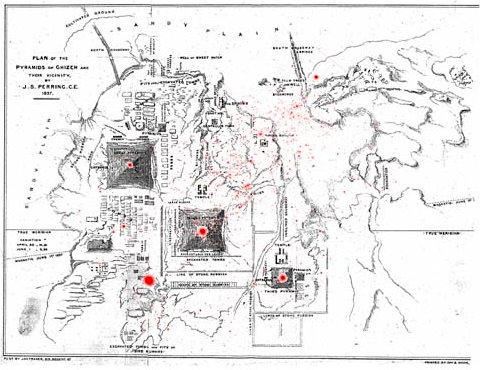
One example of the match between the Cygnus wing stars (in red) and the peaks of the three Giza Pyramids. This was done before proper motion or refraction had been taken into consideration (Pic: Rodney Hale using John Perring's plan of c. 1839-40).
Cygnus in Context
On paper a Cygnus-Giza overlay looked impressive, but it would only be valid if it could be shown that the star system played an important role in the creation myths and funerary beliefs of the Pyramid Builders. Well, it did, according, that is, to American astronomer Dr Ronald Wells. He worked for many years in the field of Egyptology, and in various academic papers published in the 1980s and 1990s Wells proposed that the ancient Egyptian sky-goddess Nuit, depicted often on tomb walls, sarcophagi, coffins or on papyri scrolls as a naked woman arched over Geb, the earth god, was personified in the heavens not simply as the sky itself, but as the Milky Way. The trail of stars making up the northern part of the Milky Way can easily be seen as a naked woman, her head in the region of Gemini, and her thighs and legs formed by the twin streams created by the so-called Great Rift, or Cygnus Rift - the long dark region of stellar dust and debris that runs down the centre of the starry river before opening out in the region of Sagittarius and Scorpio.
 | The sky-goddess Nuit seen in her perceived role as the Milky Way, with her head in the region of Gemini and her feet in the area of Sagittarius. Her womb and birth canal fall in the vicinity of the Cygnus constellation, which marks the commencement of the Great Rift, known also as the Cygnus Rift (Pic: Rodney Hale/Andrew Collins, after Dr Ronald Wells). |
If
all this was right then the sky-goddess's navel, womb, birth canal and inner thighs
corresponded with the part of the Milky Way occupied by the stars of Cygnus and
the commencement of the Cygnus Rift. Thus it would have been from the Cygnus region
that Nuit would have been seen to conceive, gestate and give birth to her son
Osiris, the god with whom all pharoahs were associated in death. More significantly,
it is from this conceptualised cosmic womb that the deceased pharaoh achieved
renewal within the pyramid and ascended to become an akh, or glorious spirit,
quite literally a star in the night sky.
During the Old Kingdom various
pyramids were given names that reflected either their astral connections or the
idea that they were places of transformation or ascension. Eventually, around
c. 2350 BC, the burial chambers of pyramids were adorned with hieroglyphic texts
that affirmed the relationship between the rebirth of the deceased as an Osiris
within Nuit's body through their interment in the tomb, sarcophagus and burial
chamber. For instance, the opening line in these so-called Pyramid Texts reads:
Recitation by Nuit, the great beneficent: The king is my eldest son who split open my womb; he is my beloved, with whom I am well pleased (PT 1)
This is to be taken as Nuit being pleased not only with his achievements in life, but also that he has returned to her womb, affirmed by his presence in the sarcophagus and burial chamber. This surmise is compounded later on in the text when the deceased is addressed:
As
you are given to your mother Nuit in her name of sarcophagi;
She has drawn
you together in her name of "burial chambers",
As
you are made to rise up to her in her name of "tomb" (PT 364)
With
this in mind, there was every good reason to conclude that the Pyramid Builders
might have constructed the Giza pyramid field to reflect the astronomical positions
of key stars that symbolised the cosmic womb of Nuit, provided it can adequately
be shown that her celestial form was that of the Milky Way, her loins formed by
its division into two separate starry streams at the start of the Great Rift.
The Body of Nuit
Yet there is more. Nuit's body, both in a celestial and symbolic sense, was equated with the Duat, a tunnel-like underworld and waterway, through which the sun, and stars that had set, were seen to travel during the hours of darkness. Each night the dying sun, after setting on the western horizon, was thought to be swallowed by Nuit, who then passed it through her body in its role as the Duat. Here the sun-god, under the name Re (or Amun-Re or Osiris), received renewal prior to its re-emergence at dawn on the eastern horizon. The journey of the sun through the night was equated by the ancient Egyptians with the passage of the soul through the underworld. To understand the trials of the sun through the hours of darkness was to know the route of the soul into the afterlife.
| Right, the sky-gooddess Nuit in her role as the swallower of the dying sun, which passes through her body and is reborn anew from between her loins at dawn on the eastern horizon. | 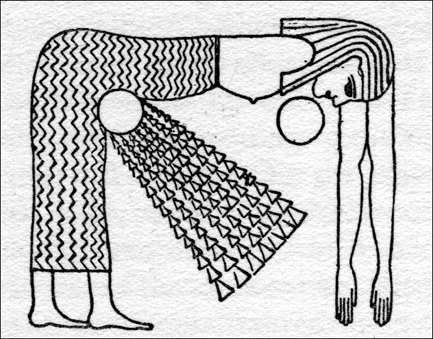 |
What astronomer Dr Ronald Wells demonstrated is that the sun-god was symbolically "swallowed", or received, at sunset by Nuit in her role as the Milky Way in the vicinity of the constellation of Gemini, one of the two points on the starry stream where the ecliptic, the sun's path, makes its crossing. Close by, and just on the edge of the Milky Way, would have been the constellation of Orion, which many scholars equate with the star Sah in the Pyramid Texts. If this is correct, then utterances within the texts that speak of Osiris becoming at one with the star Sah might well relate to the dying sun being received into the body of Nuit in her capacity as both the Milky Way and the celestial Duat, expressions ably echoed by Robert Bauval in his Orion correlation theory.
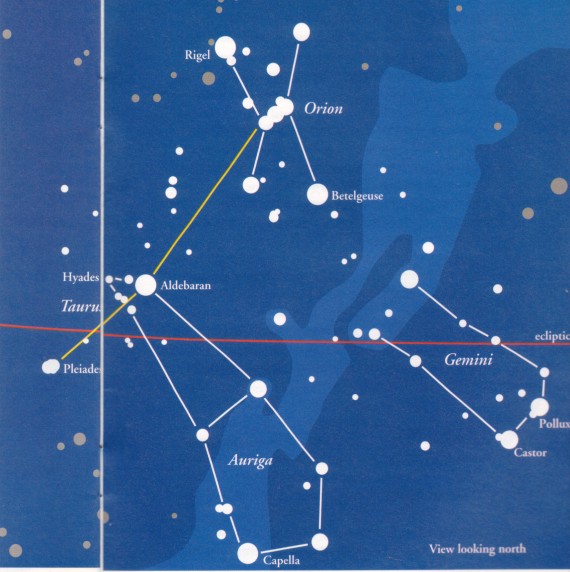 | The Milky Way in the area of Gemini and Orion. If the constellation of Orion was the star Sah in the Pyramid Texts, the utterances speaking of Osiris becoming at one with Sah might well relate to the deceased, in their guise as the dying sun, being received back into the body of Nuit in her role as the Mlky Way and celestial Duat. |
Having been taken back into the embrace of Nuit, the sun gains its renewal within her body, or more specifically her womb, marked by the stars of Cygnus, and is then released from her into the Great Rift where finally it gains rebirth at dawn on the eastern horizon. This occurs at a point corresponding with the second of the two places where the ecliptic crosses the Milky Way, which is in the proximity of the constellation of Sagittarius.
Wells
proposed that this tradition pre-dated even
the Pyramid Age (he offered a date of 3500 BC for its inception), and that the
rebirth of the sun was originally celebrated at the winter solstice, when its
appearance on the eastern horizon was heralded by the rising in the pre-dawn sky
of the stars of Cygnus (in later times the summer solstice became the time of
renewal in the ancient Egyptian calendar, coinciding as it did with the annual
inundation of the Nile).
Duat
of Memphis
Funerary
texts, in particular the "Book of That Which is in the Duat", which
dates to the New Kingdom, c. 1550-1050 BC, make it clear that a section of the
Duat-underworld, known as the Duat of Memphis, was thought to exist in the vicinity
of the Memphite necropolis on the west bank of Nile. This formed part of a much
larger tunnel-like realm, divided up into twelve symbolic hours of darkness, through
which the sun was seen to journey from sunset to sunrise. Indeed, one section
of the Duat of Memphis, which forms the fourth and fifth hours of the night, was
called "the road to the secret things of Rostau", with Rostau being
the ancient name of the Giza pyramid field. Rostau itself means the "mouth
of the passages", a possible allusion to an entrance into this cave-like
underworld. So the idea that the pharaoh in his role as both Osiris, and the sun-god
Re, should gain rebirth and transformation in the region of Cygnus, Nuit's celestial
womb, which was itself the role model of the Egyptian tomb, strengthens any reasoning
behind the idea that the Giza Pyramids might reflect the astronomical positions
of the three Cygnus "wing" stars.
The Controversy Begins
The Cygnus-Giza correlation first appeared in the author's book The Cygnus Mystery (2006), which highlighted the constellation's significance to cultures and religions worldwide. Almost immediately, this proposed new star correlation at Giza became a topic of discussion online. The author, with the help of Rodney Hale, held his ground firmly against detractors. Yet there was a single blow to the Cygnus-Giza correlation that did dent its credibility. On being asked whether proper motion had been taken into account with respect to the ground-sky overlay, the answer was "no".
The
proper motion of stars results from their slow shift in position, caused by any
number of factors, including orbits around galaxy centres, being knocked off course
by another stellar object, or movement caused by erratic spin rates. The belt
stars of Orion have not moved very far in the past 4,500 years, but one star in
Cygnus has shifted position quite considerably. This is Gienah (Epsilon Cygni),
the left-hand "wing" star, which in the Cygnus-Giza correlation corresponds
to the Third Pyramid. Its proper motion has been enough to alter its position
very slighlty across the millennia. When taking this movement into account, the
Cygnus-Giza overlay remained valid, although it was now visually less impressive,
with Gienah falling three quarters of the way down the Third Pyramid's eastern
face (the other two stars, Delta Cygni, corresponding to the Great Pyramid and
Sadr (Gamma Cygni), corresponding to the Second Pyramid, being unaffected if the
offset is placed on the relationship between Gienah and the Third Pyramid). This
was the situation when the Cygnus-Giza correlation appeared in the author's book
Beneath the Pyramids
(2009).
 | 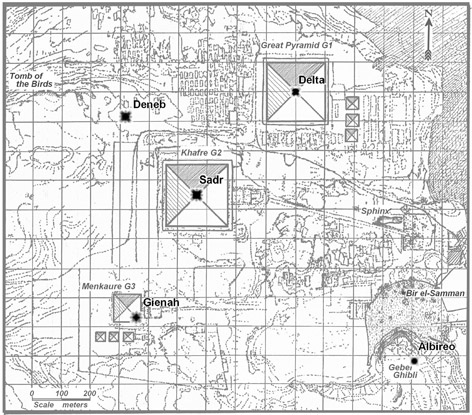 |
Left,
the Orion Correlation Theory against, right, the Cygnus-Giza correlation as it
stood with proper motion taken into account, in the author's book Beneath
the Pyramids (2009). It was later realised that the proper motion for the Cygnus
wing star Gienah had been overestimated, causing a greater error in the Cygnus-Giza
overlay than was necessary (pics: Rodney Hale).
A Re-evaluation of Proper Motion and Light Refraction
This brings us to July 2011, when Rodney Hale and the author realised that in our haste to redress the earlier miscalculations in the Cygnus-Giza correlation we had overcompensated for the proper motion of the star Gienah, leading to a much greater offset between this star and the peak of the Third Pyramid. In other words, we had done ourselves an injustice. What is more, we had not taken into account something else that might have corrected the correlation still further. We realised that transferring the astronomical positions of any stars on to the ground in order to decide the placement of architectural features was more easily achieved when the stars in question were either close to or actually on the horizon.
At such times it would have been easy for an ancient astronomer or surveyor to have recorded the positions of the stars, perhaps employing the use of sighting poles to mark a star's azimuth and elevation above the horizon. Such a task is unlikely to have been attempted when the stars were high in the sky, since it would have been totally impractical. The problem here is that the position of stars as they hover above the horizon is different to when they are overhead, due to refraction. This is caused by the manner in which light bends in accordance with the curvature of the earth. This effect results in the visual appearance of distant objects, such as stars either on or near the horizon, being "lifted" upwards by up to half a degree. In other words, it causes objects that are about to set to linger longer than they would do under any other circumstances, and this in turn distorts, very slightly, the shape of constellations. Luckily, however, the values associated with refraction are known and so can be easily calculated to give a more accurate picture of how a constellation might appear as its stars set on the horizon.
So if Cygnus did figure in the layout of the Giza Pyramids, and the astronomical positions of the stars were indeed recorded when either on or close to the horizon, then it would have a slight bearing on the Cygnus-Giza correlation. In fact, it actually favours the correlation to such a degree that with the new calculations for proper motion and refraction taken into account the match between the three stars and their respective pyramids is once more virtually perfect.
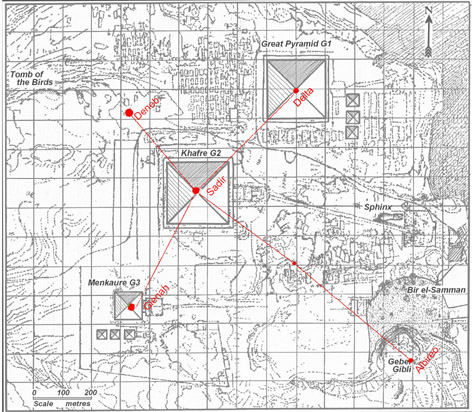 | The best match for the Cygnus wing stars and the three Giza Pyramids taking into account the correct proper motion for the star Gienah and the slight adjustment for refraction (which really only affects the position of Gienah - shown as the gap between the end of the line and the star - since it would have been the nearest star to the horizon when measured). The other key stars are only marked for comparison with the whole Cygnus star group. (pic: Rodney Hale). |
Cygnus-Giza
Correlation on both a Vertical and Horizontal Plane
Yet there is much more than simply this overhead correlation to demonstrate the importance of Cygnus to the design and placement of the Giza Pyramids. Their three apexes form a perfect arc of a circle, and when the centre of this circle is plotted on a map we find that it falls approximately 2800 m (1.73 miles) southeast of the Second Pyramid (the azimuth bearing of this sighting line from the Second Pyramid is 142 degrees east of north).(1) Geographically this centre point falls in the vicinity of a disused factory about 1 km (2/3rd of a mile) south of the village of Kafr el-Gebel.
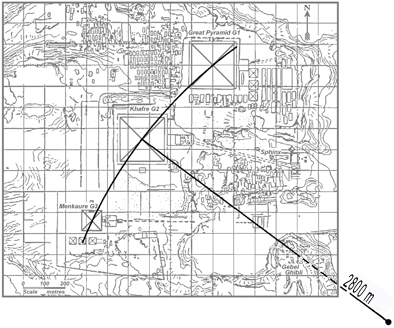 | Left, the arc of a circle made by the peaks of the Giza Pyramids. When the centre of this circle is plotted on a map, it falls approximately 2800 m (1.73 miles) southeast of the apex of the Second Pyramid. |
The importance of this realisation is that when standing at the centre of the arc circle during the Pyramid Age the three Cygnus wing stars would have been seen to set into the peaks of their corresponding Pyramids as defined by the Cygnus-Giza correlation, which we find works in both the vertical and horizontal plane.
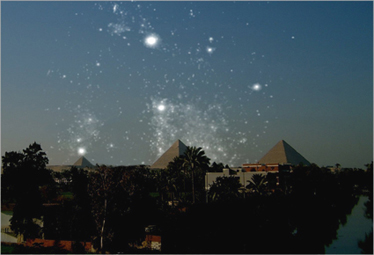 | 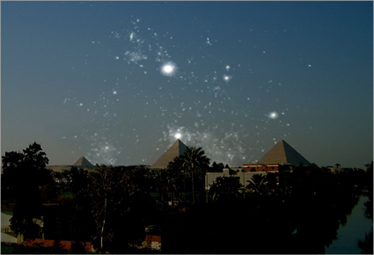 | 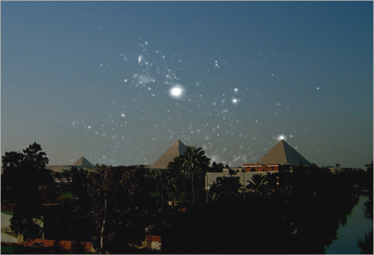 |
The three Cygnus wing stars setting down into the peaks of their corresponding pyramids in the Cygnus-Giza correlation as seen from the centre of the arc circle c. 2600-2500 BC. First Gienah would set into the peak of the Third Pyramid, then the star Sadr would descend into the peak of the Second Pyramid, and finally Delta Cygni would set into the peak of the Great Pyramid (Pics: Rodney Hale).
The Setting Stars of Cygnus
Of even more interest is that falling on the sighting line between the convergence point at the centre of the arc circle beyond Kafr el-Gebel and the Second Pyramid is Gebel Gibli, a prominent rocky eminence located several hundred metres due south of the Great Sphinx. It seems likely that this elevated site, which provides a perfect vision of all the plateau's key monuments, served as an original datum point for the development of the pyramid field (indeed, it was the start point of Mark Lehner's extensive survey of the pyramid field as part of the Giza Plateau Mapping Project). The Dream Stela of Thutmose IV between the paws of the Sphinx alludes to somewhere nearby called "the Splendid Place of the First Time (zep tepi)", and a good argument can be made to demonstrate that this is a reference to Gebel Gibli in its role as a primeval mound (see the author's book Beneath the Pyramids and also Robert Bauval's The Secret Chamber, 1999). Indeed, one local name for Gebel Gibli is Tarfiye, which is interpreted as meaning the "first place", or the "place of beginning".
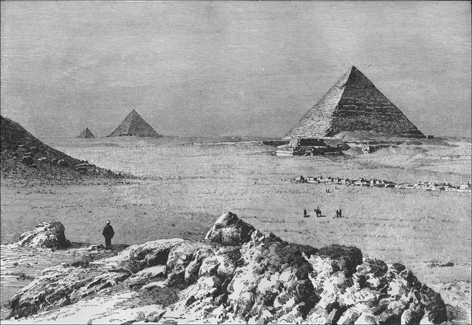
The heights of Gebel Gibli, Giza's southern mount, as seen in a nineteenth century illustration (pic: Andrew Collins).
Although
the Cygnus wing stars would have been seen to set into the peaks of the three
pyramids from the centre of the arc circle at Kafr el-Gebel during the Pyramid
Age, if you were move back along the sighting line towards the plateau, the ever
widening gap between the pyramids as they got closer would mean that by the time
you climbed the heights of Gebel Gibli and looked out over the pyramid field all
the Cygnus stars would now be setting down into just one pyramid - the one in
the middle - the Pyramid of Khafre (G2 as it is known). Indeed, during the Pyramid
Age the observer standing on Gebel Gibli would have seen Deneb, Cygnus's brightest
star, set down into its apex just as the Milky Way would have appeared to be rising
like some celestial mist from its sides.
Immediately beyond and in line
with the Second Pyramid and this spectacular scene, as seen from Gebel Gibli,
is the entrance to Giza's recently rediscovered cave underworld, entered via the
plateau's north cliff, almost as if the Milky Way and the stars of Cygnus were
sinking into this subterranean world, symbolic of the Duat itself. Was
all this purely coincidence, or had there been some kind of precision placement
and design of key monuments at Giza to both reflect the astral influence of and
lock into the cyclic mechanisms of these important visual components of the night
sky?
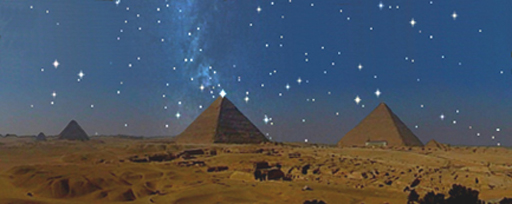
The view from Gebel Gibli, to the south of the Sphinx, during the Pyramid age. The stars of Cygnus, along with the Milky Way, would have set down into the Second Pyramid, with the bright star Deneb setting into the pyramid's apex. The entrance to Giza's cave underworld lies directly behind the Second Pyramid as viewed from the heights of Gebel Gibli (pic: Rodney Hale/Andrew Collins).
Landscape
Geometry
Confirming the apparent significance of the Cygnus correlation with respect to the Giza complex is its conformity to some basic geometry on the ground. For example, a precise equilateral triangle can be drawn embracing the peaks of Gebel Gibli, the Great Pyramid and the Third Pyramid. A line bisecting this triangle from its corner on Gebel Gibli not only targets the apex of the Second Pyramid, but also corresponds precisely with the sighting line from the convergence point of the arc circle beyond Kafr el-Gebel, locking in this simple trigonometry with the Cygnus correlation.
The line that bisects the equilateral triangle also forms the hypotenuse, or longest side, of a right-angled, 3:4:5 sided, Pythagorean triangle, whose other sides are aligned precisely towards the cardinal points. This great triangle perfectly embraces the apexes of the First and Second Pyramids and also the head of the Sphinx monument, which lies half way along its north-south line. It is very likely that this line, which begins on the summit of Gebel Gibli, constitutes a datum line used in the grand design of the pyramid field. At the northwest corner of the triangle is the Tomb of the Birds (NC2), the entrance to the aforementioned cave system, rediscovered after nearly 200 years of obscurity by Egyptological researcher Nigel Skinner-Simpson and the author, and entered by them for the first time in March 2008.
None of this is likely to be coincidence. The Cygnus-Giza correlation, with its accompanying geometry, is visually more effective than any other similar theory concerning a grand unified plan at Giza. The evidence presented here acts as the foundation for a new understanding of the mindset behind pyramid construction during the Old Kingdom - one that features Cygnus as the place of transformation and rebirth of the pharaoh, and his role as a shining spirit (akh) among the stars.
It seems likely that the Cygnus-Giza sighting line that stems from the convergence point of the arc centre at Kafr el-Gebel and targets both the apex of the Second Pyramid and the entrance (to within 50 m) to Giza's cave underworld was highly significant in its own right. Very possibly this line marked the course of the Duat of Memphis, signified by the manner in which the Milky Way (as the body of Nuit in its role as the Duat), and in particular the start of the Cygnus Rift, seemed to "enter" Giza's cave underworld as seen from Gebel Gibli. Perhaps the Duat of Memphis was thought to pass beneath the ground coincident to the sighting line, carrying with it both the stars of Cygnus and the Milky Way, the reason why the Giza Pyramids were laid out to reflect the Cygnus wing stars as they set down into the northwest horizon.
If
correct, then it must be considered possible that this sighting line acted as
a symbolic representation of the "road to the secret things of Rostau"
described in connection with the Duat of Memphis in the transformation text known
as "The Book of That Which is in the Duat". Although, in its current
form, this dates only to the New Kingdom period, there seems every reason to suspect
that it is based on a much earlier tradition that stretched back to the Pyramid
Age and featured Giza in its role as Rostau, the "mouth of the passages",
which is surely an allusion to Giza's cave underworld.
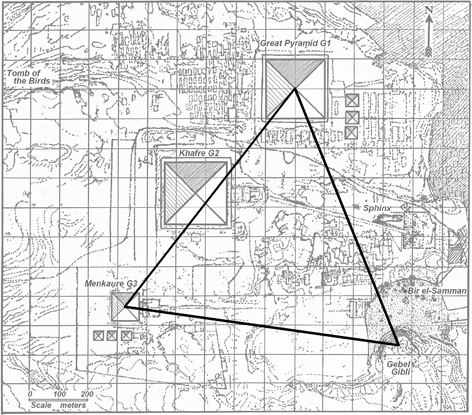 | 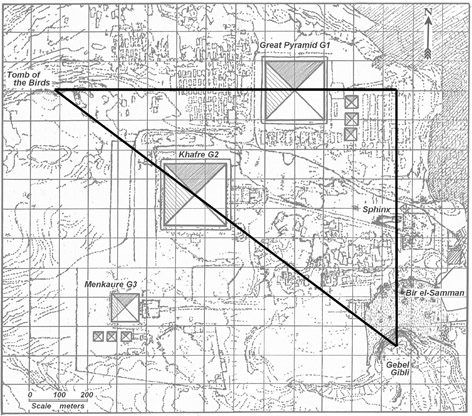 |
Left,
the equilateral triangle formed by linking the peak of Gebel Gibli (bottom right)
with the apexes of the Great Pyramid and Third Pyramid. Right, the 3:4:5 Pythagorean
triangle embracing the summit of Gebel Gibli and the apexes of the Great Pyramid
and Second Pyramid. The head of the Sphinx falls half way along the side of the
triangle's north-south line, which might well have acted as a datum line in the
creation of the pyramid field (Pics: Rodney Hale).
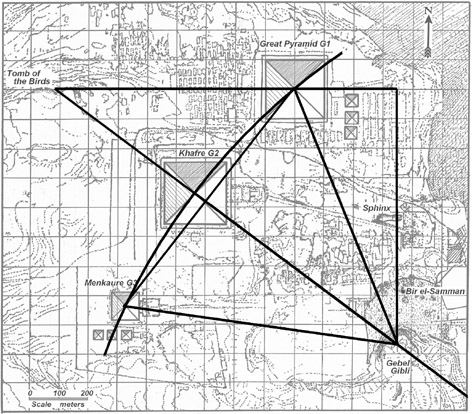 | The equilateral triangle embracing Gebel Gibli, the Great Pyramid and the Third Pyramid, overlaid upon the arc of the circle formed by the peaks of the three pyramids, and the 3:4:5 Pythagorean triangle embracing Gebel Gibli, the Sphinx's head, the peaks of the Great Pyramid and Second Pyramid, and, finally, the Tomb of the Birds (NC2), the entrance to Giza's cave underworld. Note how the Pythagorean triangle's hypotenuse bisects (within one degree) the equilateral triangle, whilst this same line, which defines also the sighting line coming from the centre of the arc circle, and thus the Cygnus-Giza correlation, exactly defines the placement of the Three Pyramids. (pic: Rodney Hale). |
Although these ideas favour the Cygnus constellation in Giza's cosmic blueprint, it cannot be denied that the Orion constellation also played a major role in the funerary traditions of the Pyramid Builders, and might well have featured in a much greater cosmological scheme that embraced the use of several key stars and constellations, including Cygnus, Draco, Ursa Major, Canopus and the bright star Sirius.
In Part Two of this article, we shall explore the convergence point or centre or the arc circle beyond Nazlet el-Batran. Here we have located the site of a possible kom, or occupational mound, that may well have marked the location of a primeval mound that existed before even the age of the Pyramids.
Notes
1. The centre of the arc circle, created by the peaks of the three Giza Pyramids, has been determined using the raw data of Sir William Flinders-Petrie's 1880-82 survey of the pyramid field, using a maximum tolerance of 5 m in the positions of individual pyramids. The only other available survey data for the Giza pyramid field was collected by Dr Mark Lehner, founder of the Ancient Egypt Research Associates (AERA) for the ongoing Giza Plateau Mapping Project (GPMP), and to date this has not been made available to researchers. However, the plan created by the GPMP from this data conforms virtually perfectly with Petrie's survey, reconfirming its validity in the modern age. The author and Rodney Hale are aware of any errors incorporated into Petrie's published data.
Hale's original calculations for the centre of the arc centre, published in Beneath the Pyramids, placed it at a distance of 2360 m from the peak of the Second Pyramid. This estimate has now been revised based on the aforementioned tolerances.
CLICK
TO READ PART TWO OF THIS ARTICLE:
THE
SEARCH FOR EGYPT'S MOUND OF CREATION
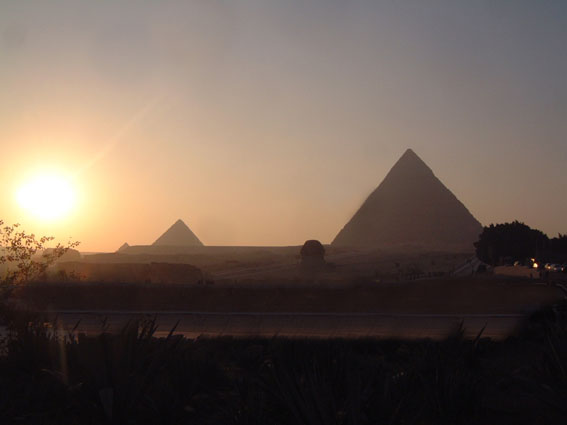
To
explore the topic of this article more fully please consult the author's books
The Cygnus Mystery and
Beneath the Pyramids,
and the DVDs "The Cygnus Mystery"
and "The Lost Caves of Giza".
For more information click here.
Note: All pics are the copyright of those indicated in the captions. The Giza plan was drawn by artist Yuri Leitch based on the original by the Giza Plateau Mapping Project.
Thanks
go out to Rodney Hale, Greg Little, Janet Morris and Nigel Skinner Simpson for
their help in the compilation of this article.